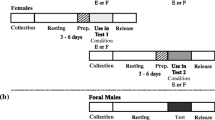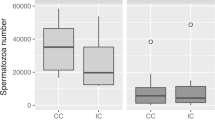Abstract
The tropical spirostreptid millipede Alloporus uncinatus has a polygynandrous mating pattern that is apparently shaped by sperm competition (Telford and Dangerfield 1990, 1993a). In the present study radioisotopic labelling of ejaculates was used to quantify the temporal effects of double mating sequences on sperm precedence patterns. Ejaculates of successive males mix completely within the sperm storage organs and are concentrated close to the site of fertilisation, the spermathecal-oviduct junction. When matings follow each other immediately (experiment 1), equal volumes of the ejaculates of each male are stored within the spermathecae, and both males have equal probability of paternity. Where matings are separated by a 24-h delay (experiment 2), the volumetric contribution of the first male is reduced by 54.8 % and last male precedence operates. Although the distal ends of the gonopods play a primary role in the redistribution of ejaculates (Barnett and Telford 1994), by using a single mating sequence we show that they are not responsible for the reduction in ejaculate volume. The most likely explanation is absorption and/or ejection of the first male's ejaculate by the female. Genital functional morphology is used to reconstruct the mechanism of ejaculate distribution.
Similar content being viewed by others
References
Barnett M, Telford SR (1994) The timing of insemination and its implications for sperm competition in a millipede with prolonged copulation. Anim Behav 48:482–484
Barnett M, Telford SR (in press) Sperm competition and the evolution of millipede genitalia. Bull Mus Hist Nat Paris, in press
Barnett M, Telford SR, Villiers CJ de (1993) Sperm displacement in a millipede? — an investigation into the genital morphology of the southern African spirostreptid millipede Orthoporus pyrhocephalus. J Zool Lond 211:511–522
Berrigan D, Locke SJ (1991) Body size and male reproductive performance in the flesh fly, Neobellieria bullata. J Insect Physiol 37:575–581
Birkhead TR, Hunter FM (1990) Mechanisms of sperm competition. Trends Ecol Evol 5:48–52
Birkhead TR, Møller AP (1992) Sperm competition in birds. Evolutionary causes and consequences. Academic Press, New York
Birkhead TR, Møller AP (1993) Female control of paternity. Trends Ecol Evol 8:100–104
Eberhard WG (1985) Sexual selection and animal genitalia. Harvard University Press, Cambridge
Eberhard WG (1991) Copulatory courtship and cryptic female choice in insects. Biol Rev 66:1–31
Gage MJG (1992) Removal of rival sperm during copulation in a beetle, Tenebrio molitor. Anim Behav 44:587–589
Gwynne DT (1984) Male mating effort, confidence of paternity, and insect sperm competition. In: Smith RH (ed) Sperm competition and the evolution of animal mating systems. Academic Press, New York, pp 117–144
Hopkin S, Read H (1992) The biology of millipedes. Oxford University Press, Oxford
Knowlton N, Greenwell SR (1984) Male sperm competition avoidance mechanisms: the influence of female interests. In: Smith RH (ed) Sperm competition and the evolution of animal mating systems. Academic Press, New York, pp 62–83
McVey ME, Smittle BJ (1984) Sperm precedence in the dragonfly Erythemis simplicicollis. J Insect Physiol 30:619–628
Parker GA (1974) Courtship persistence and female-guarding as male time investment strategies. Behaviour 48:157–184
Parker GA (1970a) Sperm competition and its evolutionary consequences in the insects. Biol Rev 45:525–567
Parker GA (1970b) Sperm competition and its evolutionary effect on copula duration in the fly Scatophaga stercoraria. J Insect Physiol 16:1301–1328
Radwan J (1991) Sperm competition in the mite Caloglyphus berlesei. Behav Ecol Sociobiol 29:291–296
Radwan J, Witalinski W (1991) Sperm competition. Nature 352: 671–672
Retnakaran A (1974) The mechanism of sperm precedence in the spruce budworm Choristoneura fumiferana (Lepidoptera: Tortricidae) Can Entomol 106:1189–1195
Rubenstein DI (1989) Sperm competition in the water strider, Gerris remigis. Anim Behav 38:631–636
Siegel S, Castellan NJ (1988) Non-parametric statistics for the behavioural sciences. McGraw-Hill, New York
Siva-Jothy MT (1988) Sperm “repositioning” in Crocothemis crythrae, a libellulid dragonfly with a brief copulation. J Insect Behav 1(2):235–245
Sillén-Tullberg B (1981) Prolonged copulation: a male ‘postcopulatory’ strategy in a promiscuous species, Lygaeus equestris (Heteroptera: Lygaeidae). Behav Ecol Sociobiol 9:283–289
Smith RH (1984) Sperm competition and the evolution of animal mating systems. Academic Press, New York
Telford SR, Dangerfield JM (1990) Manipulation of the sex-ratio and duration of copulation in the tropical millipede Alloporus uncinatus — a test of the copulatory guarding hypothesis. Anim Behav 40:984–986
Telford SR, Dangerfield JM (1993a) Mating tactics in the tropical millipede Alloporus uncinatus (Diplopoda: Spirostreptidae). Behaviour 124:45–56
Telford SR, Dangerfield JM (1993b) Mating behaviour and mate choice experiments in some tropical juliform millipedes. S Afr J Zool 28:155–160
Telford SR, Dangerfield JM (1994) Males control the duration of copulation in the tropical millipede Alloporus uncinatus. S Afr J Zool 29(4):266–268
Thornhill R (1983) Cryptic female choice and its implications in the scorpionfly Harpobittacus nigriceps. Am Nat 122:765–788
Tsubaki Y, Yamagishi M (1991) “Longevity” of sperm within the female of the melon fly, Dacus cucurbitae (Diptera:Tephritidae), and its relevance to sperm competition. J Insect Behav 4:243–250
Villavaso EJ (1975) Functions of the spermathecal muscle of the boll weevil, Anthonomus grandis. J Insect Physiol 21:1275–1278
Waage JK (1979a) Adaptive significance of postcopulatory guarding of mates and non-mates by Calopteryx maculata (Odonata). Behav Ecol Sociobiol 6:147–154
Waage JK (1979b) Dual function of the damselfly penis: sperm removal and sperm transfer. Science 203:916–918
Waage JK (1982) Sperm displacement by male Lestes vigilax (Zygoptera: Lestidae). Odonatologica 11:201–209
Waage JK (1986) Sperm displacement by two libellulid dragonflies with disparate copulation durations (Anisoptera). Odonatologica 15:426–444
Walker WF (1980) Sperm utilisation strategies in non-social insects. Am Nat 115:780–799
Ward PI (1993) Females influence sperm storage and use in the yellow dung fly Scatophaga stercoraria. Behav Ecol Sociobiol 32:313–319
Author information
Authors and Affiliations
Additional information
Communicated by M.A. Elgar
Rights and permissions
About this article
Cite this article
Barnett, M., Telford, S.R. & Tibbles, B.J. Female mediation of sperm competition in the millipede Alloporus uncinatus (Diplopoda: Spirostreptidae). Behav Ecol Sociobiol 36, 413–419 (1995). https://doi.org/10.1007/BF00177337
Received:
Accepted:
Issue Date:
DOI: https://doi.org/10.1007/BF00177337




